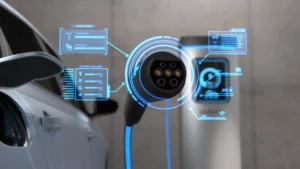
Home / EV Charging News / Networked EV Charging Stations: Benefits of Remote Monitoring and Management
As electric vehicle (EV) adoption continues to accelerate, organizations are increasingly turning to networked EV charging stations to manage their charging infrastructure more efficiently. Unlike standalone chargers, networked stations are connected through a centralized system that enables remote monitoring, control, and optimization of charging operations. In this article, Nick Zamanov, EV infrastructure expert at CyberSwitching, explores the key benefits of networked EV charging stations and how remote management enhances operational efficiency, energy savings, and user experience.
Networked EV charging stations are smart chargers that communicate with a central software platform via the internet or a local network. This connectivity allows real-time data exchange, remote control of charging functions, and centralized oversight of multiple charging points. With networked systems, operators can track usage, perform diagnostics, set user permissions, and even adjust power levels from anywhere.
Whether managing a single commercial property or a multi-site fleet, networked charging infrastructure provides a scalable and flexible solution that ensures optimal performance with minimal on-site intervention.
One of the most valuable features of networked charging stations is the ability to monitor charging sessions in real-time. Operators can view charger status, energy usage, charging speed, and session duration through a centralized dashboard. If an issue arises—such as a charging error or connectivity problem—alerts are triggered instantly, allowing for immediate troubleshooting and reduced downtime.
With remote diagnostics and error reporting, technical issues can be identified and addressed before they escalate. This proactive approach minimizes equipment failure, reduces costly on-site visits, and ensures charging stations remain operational for users.
Networked systems provide detailed reports and analytics, helping businesses understand charging patterns, peak usage times, and energy consumption. This data can be used to refine charging strategies, forecast infrastructure needs, and optimize load management.
Networked EV chargers support remote configuration, allowing operators to set pricing, user access, or energy limits without being on-site. Fleet operators and property managers can control who uses the chargers, when they charge, and how much power they receive—ensuring fair and efficient usage across all users.
By combining remote management with smart scheduling and load balancing, networked stations help businesses avoid peak energy rates and reduce demand charges. This leads to more predictable electricity bills and more sustainable energy practices.
Whether you’re operating a small fleet or managing a nationwide network of stations, a centralized control system makes it easy to scale. Networked infrastructure allows businesses to add new chargers and sites without reinventing the wheel—ensuring consistent performance and easy oversight from a single platform.
Networked EV chargers can be integrated with Building Energy Management Systems (BEMS), Dynamic Load Management (DLM) platforms, solar generation, and battery storage. This holistic approach enhances energy efficiency, supports sustainability goals, and ensures optimal performance across all building systems.
For example, when paired with DLM, networked chargers can dynamically adjust charging speeds based on real-time grid capacity. When linked with solar and battery storage, businesses can prioritize clean energy use and reduce reliance on the grid during peak demand periods.
From fleet operators and commercial landlords to municipalities and educational campuses, more organizations are making the switch to networked EV charging. The benefits—lower operational costs, improved reliability, better energy control, and superior user experience—are hard to ignore.
At CyberSwitching, we design intelligent EV charging solutions that enable seamless network integration and remote management. Our advanced systems empower businesses to scale their charging infrastructure confidently, with complete visibility and control.
Networked EV charging stations are transforming the way businesses deploy and manage electric vehicle infrastructure. By enabling remote monitoring, intelligent control, and seamless integration with energy systems, they offer a future-proof solution that aligns with both operational and environmental goals.
To learn how CyberSwitching can help you implement a scalable, smart EV charging solution with full network capabilities, contact us today.
1. Do networked EV chargers require constant internet access?
While internet connectivity is ideal for real-time monitoring and remote control, many networked chargers can store data locally and sync when reconnected. Some models also support local area networks (LAN) for added flexibility.
2. Can I set different access permissions for different users?
Yes. Networked systems allow administrators to define user roles, set usage limits, and manage access rights through a secure platform.
3. How secure are networked EV chargers?
Leading manufacturers implement robust security protocols, including encrypted data transmission, regular firmware updates, and secure cloud hosting to protect against cyber threats.
4. Will remote monitoring reduce my maintenance costs?
Absolutely. Remote diagnostics help identify and resolve issues early, often without needing a technician on-site—saving time and reducing service costs.
5. Can I integrate networked chargers with solar panels or battery systems?
Yes. CyberSwitching’s networked solutions can integrate with solar PV and energy storage systems, enabling smart energy routing and peak shaving strategies.



